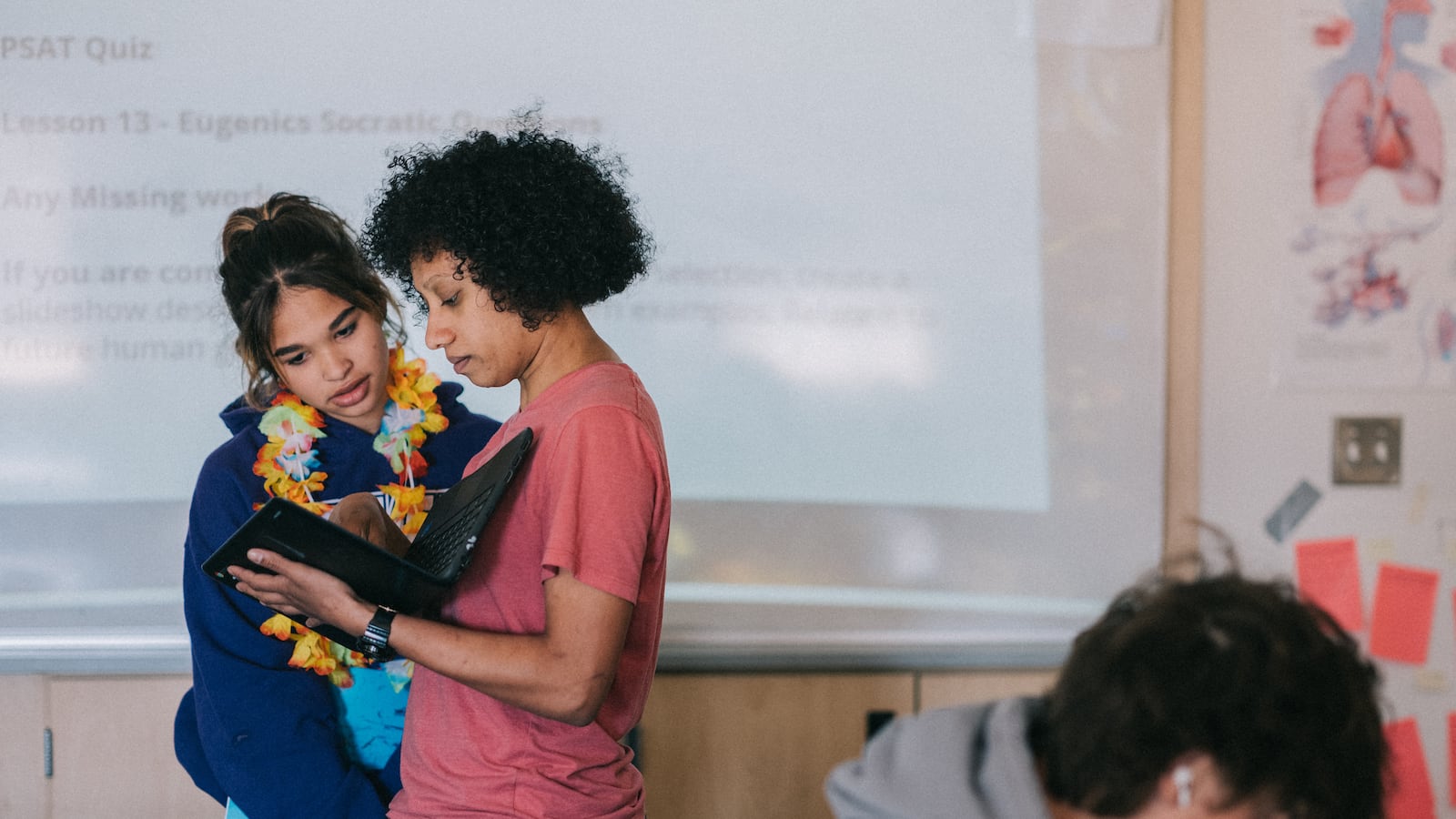This story is being co-published with The New York Times Sunday Review.
As class ended on a recent Tuesday, Ana Barros, a middle school teacher, signaled for a seventh grader wearing Crocs to hang back. Minutes earlier, he’d stormed into the hallway, slamming the door in her face.
“Walk me through that moment you just had,” she said.
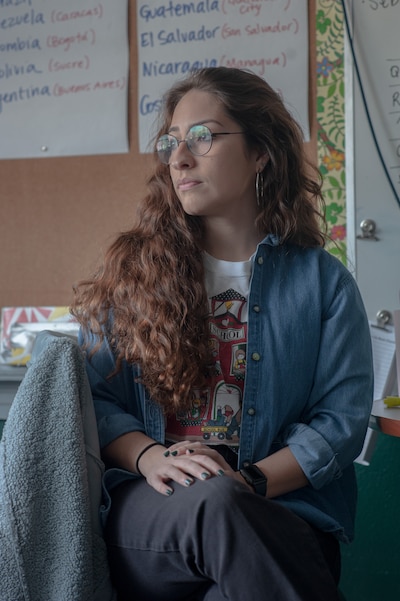
Barros, who teaches social studies at an Oklahoma charter school, listened with patience. The student had struggled to manage his emotions before the pandemic. A year spent at home when classes were fully remote without the neutral ground that school provided had intensified his anger.
“When you’re mad, when you’re feeling that rage,” she said, “you can’t slam the door.”
“Sorry,” the student replied softly, trying to keep his feelings in check.
“It’s OK,” Barros said. “But we’ve gotta find a way to channel those moments when you’ve got rage. We’re on the same team. I’m not against you. I want to help you.”
In some ways, this is typical middle school teaching. But the pandemic has upped the volume and intensity of students’ needs and raised the stakes for schools trying to meet them.
The cascade of new challenges started with the onset of the coronavirus in 2020, which closed school buildings and plunged teachers and families into the unknowns of remote learning. The year that followed was a patchwork of remote and in-person instruction, with school districts around the country varying wildly in their policies.
Many hoped this would be the comeback school year, when schools would focus on recovery. The last schools that had been operating remotely fully reopened. COVID relief dollars poured into districts. The availability of vaccines for teens, and then children over 5, created hope.
But just as the pandemic’s emotional and academic toll on students grew clearer last fall, staff shortages hobbled schools. When the virus seemed like it was under control, the omicron wave of cases brought half-empty classrooms or temporary returns to virtual learning. It’s been a year of survival and triage for teachers, school leaders, students, and their families.
Now a shift is underway. Mask mandates have largely lifted, and more Americans say they are ready to leave the pandemic in the rearview mirror. But teachers like Barros are still grappling daily with issues that COVID has left in its wake, most of which defy easy solutions.
“I really feel scared to say that we’ve turned a corner,” she said. “The things that we were struggling with, even outside of COVID, are just still there.”
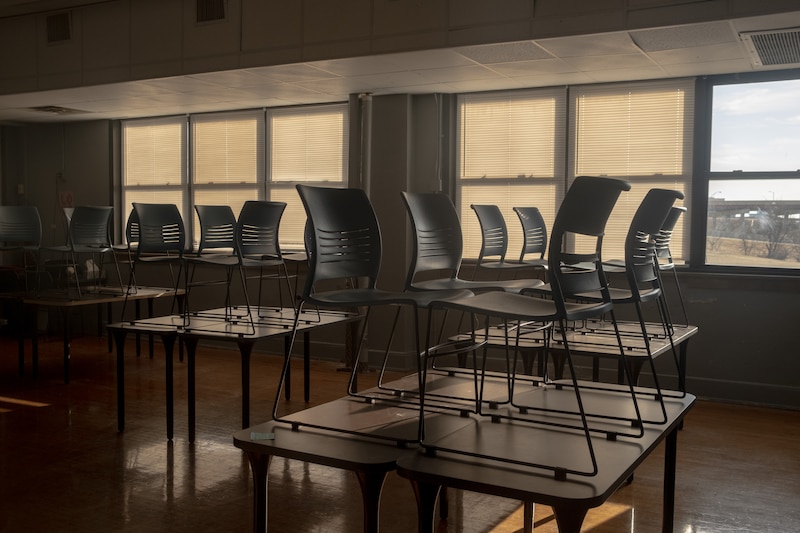
In Barros’ classroom at the Tulsa School of Arts and Sciences, many students require intensive support. One boy didn’t attend a single virtual class as a sixth grader or return when the school building reopened last spring. It’s her job to keep him tethered to school.
When another student started clutching a stuffed toy shaped like an avocado, Barros didn’t press her for a reason. And when one of Barros’ top students started having panic attacks in class, she helped come up with a plan to calm her heavy breathing. Her school has noticed an uptick in thoughts of self-harm, negative self-talk, and meltdowns. More students are asking to see the counselor.
Two years into the upheaval, teachers are depleted. On top of the needs in their classrooms, teachers and their unions have faced scrutiny over school shutdowns, vaccine and mask mandates, and COVID safety protocols, leading to labor strife in Chicago and elsewhere.
Some teachers have begun having doubts about their ability to keep going. As three colleagues departed midyear for higher-paying jobs outside the classroom, Barros, who has taught for four years in Tulsa, found herself scrolling job listings earlier this winter. Like most, she’s sticking it out. “For a while, I was in that victim mentality of ‘woe is me,’ but I do have choices,” she said. “And I’m choosing to stay because I love this.”
But America’s schools remain fragile. As teachers catch their breath after the latest wave of COVID cases, many are teetering between cautious optimism and lingering exhaustion.
Across the country, teachers like Neelah Ali are trying to help students who are struggling emotionally and keep them on track academically after two years of stop-and-start learning.
Ali teaches freshman biology at Denver’s South High School, where she is also a teacher coach, an assistant track coach, and a sponsor of the dance team, Jewish Club, and Black Student Alliance. She’s the kind of teacher who knows nearly everyone and will hop up on a table to help students understand a lesson.
Ali much prefers in-person teaching to what she called “the abyss” of virtual learning. Students had the option to return to classrooms part-time last spring and have been learning in-person all of this school year, though COVID cases meant attendance was spotty until recently. There are signs of genuine joy in school: students giggling together in class, cranking pump-up music in the weight room, and eating pizza off trays in the hallways.
But Ali says her students have less academic stamina than she is used to. Before the pandemic, all of her freshmen would most likely have finished their lab, which involved flipping pennies to determine the odds that two parents’ offspring would have dark hair or freckles, in a 50-minute class period. This year, only one pair of students did. More students are asking for breaks during class, too.
“I’m having more conversations with kids about not liking school,” Ali said.
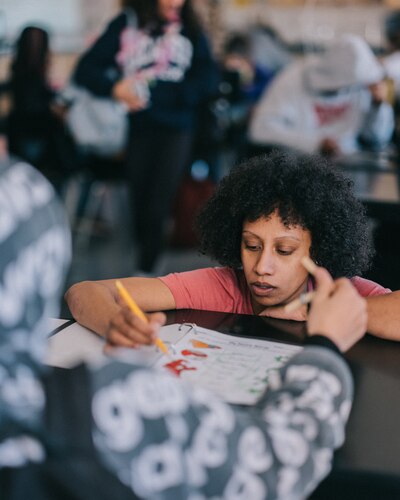
Students also seem more attached to the digital world. Despite posted signs prohibiting cellphone use, nearly all of Ali’s students on a recent day had their phones out at some point. A few used them in ways that were arguably academic, walking up to the white board and snapping a photo of the lesson on chromosomes and meiosis to copy it onto paper. For others, the phones were a distraction.
Ali knows that taking a student’s phone is likely to upset them deeply. That wasn’t as true before the pandemic, she said.
“Now it’s like, if I take the phone, it threatens their identity,” she said. “If I take it, that’s going to damage our relationship so much that I don’t even broach the topic.”
Despite the difficulties, Ali said she was getting through the curriculum, partly because the pandemic meant fewer guest speakers and field trips. But student absences because of COVID or COVID exposure have been another complication. In each of her classes, several students were on their laptops doing makeup work instead of the penny lab.
The absences, a national challenge this year especially during the omicron wave, pose a daily dilemma. When should teachers reteach a lesson that some students missed and when should they move on? The answers matter, as ninth-grade success is seen as a key predictor of whether a student will graduate from high school in four years. Last year, graduation rates dipped nationwide and more ninth graders fell behind on credits in some states.
“A lot of teachers are struggling with: Do we make it up or do we not make it up?” Ali said.
The little boy arrived in Kendra Barclay’s kindergarten classroom on a chilly Detroit morning wearing a white mask so big it was hanging off his face.
“You need a kid’s mask!” she told him, scurrying off to find one.
Mask adjustment is still part of the job for Barclay, who spent much of that morning transitioning from lessons on letter sounds to gentle, and at times stern, reminders about classroom COVID safety.
“Ch says chuh, chuh, chuh,” Barclay said as she surveyed the students sitting on the rug in front of her. “Kamryn, you’ve got to cover your nose.”
Though schools in most of the country have lifted their mask mandates, Detroit district leaders are still weighing a potential change. For now, Barclay continues navigating the physical logistics as well as the emotional toll of teaching in a community that lost thousands to COVID.
“How do you keep 5-year-olds socially distanced?” she said. “They love being near each other. A lot of them need that contact. They need to feel nurtured.”
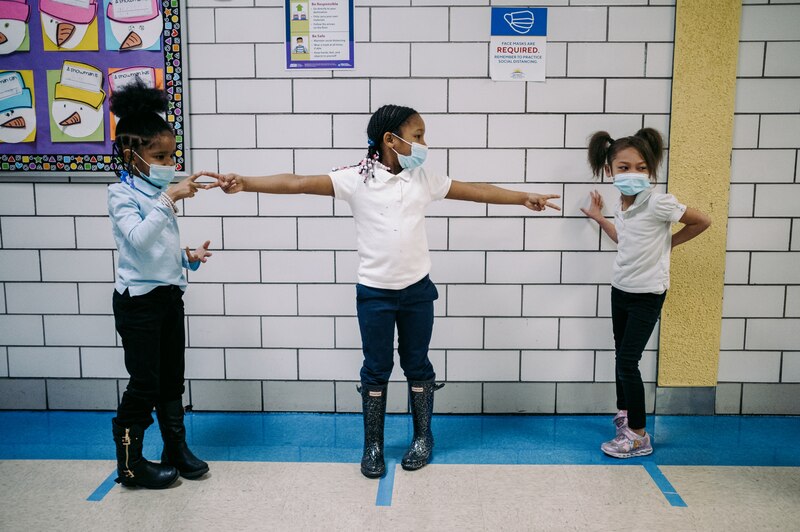
Barclay finds a way to do both, and her classroom at Spain Elementary-Middle School in the city’s Midtown neighborhood includes plenty of dancing and singing. When she needed her students to see how their tongues should sit between their teeth as they make the “th” sound, she moved to the far side of the room and pulled her two masks down for a few seconds.
Back in September, the stress of wanting to serve the students who needed her while avoiding getting sick herself got the best of Barclay, a South Carolina native who has taught in Detroit since 1999. On the school’s first in-person day, the principal, Frederick Cannon, popped his head in her classroom door before the kids arrived and asked how she was doing. Barclay burst into tears. “It was just the fear,” she says.
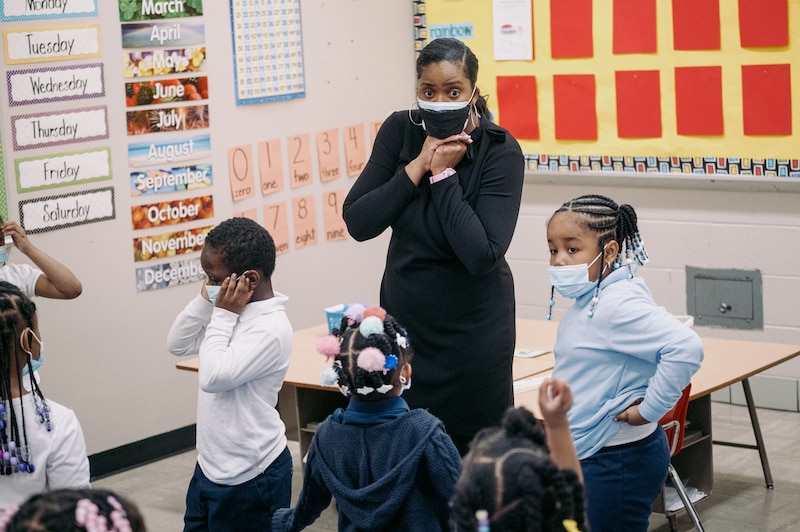
Months later, as she was beginning to feel more comfortable, a new wave of cases disrupted everyone’s lives again. Schools in the district went remote for weeks as the omicron variant spread and again for winter storms, briefly severing the connection between Barclay and some of her students. A couple of children signed in daily, but never turned their cameras on or responded when she called on them.
Barclay remains optimistic about her students’ progress and was grateful recently to be among a group of teachers who received recognition from the district for their work during the pandemic. She knows her students aren’t all where they should be academically, though. She has found herself reteaching lessons from the fall, like how to write words on the correct lines of their handwriting practice paper.
“I’m still committed to coming in every day, trying to push and pull the greatness in and out of them,” she said. “I just still worry. How many of them are going to be prepared for first grade?”
“I have to realize this is just what it is in the world right now, and I am doing all I can.”
After a winter of emotions that rose and fell with COVID case rates, the nation’s teachers and families are looking to what comes next. Whether their fatigue will stretch on through the spring and even fall. Whether their schools can turn a fragile grip on stability into a firm grasp.
This pandemic may become less acute, but its effects on schools will linger: the children coping with the death of their caregivers, the fissures that remain over how to keep kids healthy and safe, the kindergartners struggling with their ABCs, the seventh graders tamping down anxiety, the high schoolers fretting over their diplomas.
Schools are now spending big on mental health programs, tutoring, and other academic recovery efforts — work that is likely to stretch past the three years they have to use their federal relief funds. “Our hardest and most important work lies ahead,” the U.S. education secretary, Miguel Cardona, said recently.
For Ali in Denver, that work looks like a full school day followed by a three-hour virtual training on a new science curriculum that’s more inclusive and culturally relevant. The changes are important to her, but “burnout feels like it’s a lot closer than it used to be,” she said.
It’s the same for a lot of teachers she talks to, she said. The rising stress “feels like it’s more at our chest than at our feet.”
For Barclay in Detroit, the work means connecting with her students — whether by listening intently to a retelling of the plot of a “Transformers” movie or offering hugs even when they go against social distancing guidelines.
“I figure, you wouldn’t ask for a hug or a high five if you really didn’t need it,” she said.
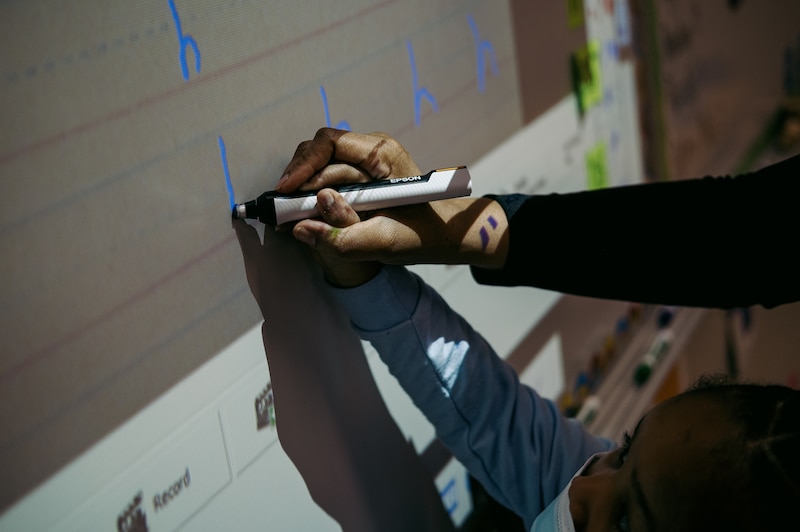
And for Barros in Tulsa, the work looks like this: grading assignments on Sundays, spending her planning periods in meetings with families whose children are struggling, and mentoring a new teacher partly to supplement her comparatively low Oklahoma teacher’s salary.
She hopes she’s pushed past the worst of her exhaustion — when she was out sick for seven school days with COVID in January, wracked with guilt, waking up each morning to record a video lesson so her students wouldn’t fall behind.
Now the end of the school year feels within reach. Come fall, she won’t be as in the dark about where her students are, academically and emotionally, as she was this year.
Other challenges aren’t going away. Barros goes without adequate staffing support even in a normal year, helping translate for the school’s Spanish-speaking families as one of the few bilingual staff members. Her school also serves a disproportionately high share of students with disabilities. Without other teachers or aides in the room to help, it’s Barros who slips a pillow under the foot of a student with autism to soften the sound of his tapping foot, and Barros who pulls aside a student with dyslexia to read tricky passages aloud.
After months back together in the school building, she’s seen her students make real progress — reading full chapter books, building friendships with classmates. But they’re still dealing with the ramifications of the COVID years. It will take a wider network of support to truly give her students what they need, Barros says. To her, that includes greater investment in Tulsa’s under-resourced neighborhoods, stronger bonds between schools and families, and more counselors and therapists.
“We haven’t seen fine, ever,” she said. Pre-pandemic, many of the students with disabilities and students of color at her school were “already so underserved.”
“I feel like I’m a piece of the puzzle, and I see myself as a piece of the puzzle,” Barros said. “And sometimes it’s like, damn, some of those pieces are taking a long time to get here.”
Kalyn Belsha is a national reporter based in Chicago. Contact her at kbelsha@chalkbeat.org. Lori Higgins is the bureau chief for Chalkbeat Detroit. Contact her at lhiggins@chalkbeat.org. Melanie Asmar is a senior reporter for Chalkbeat Colorado covering Denver Public Schools. Contact her at masmar@chalkbeat.org.


